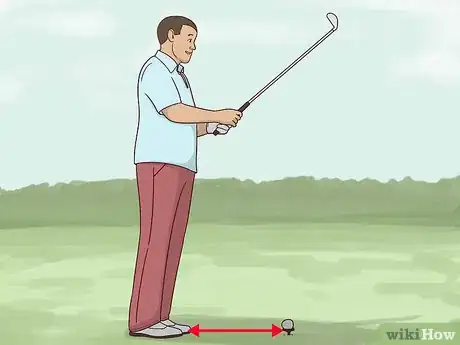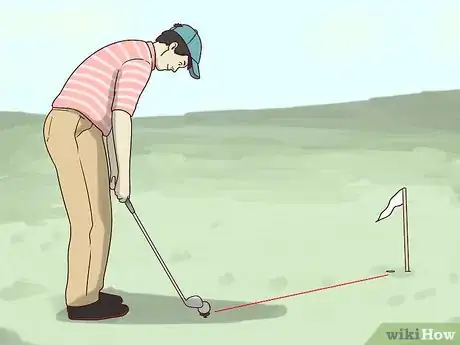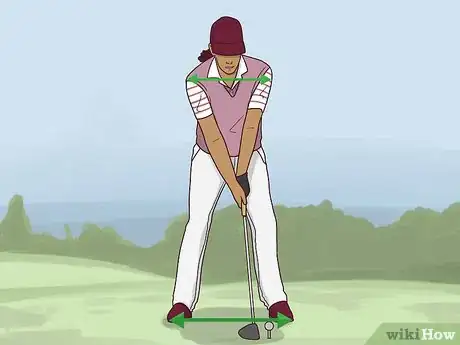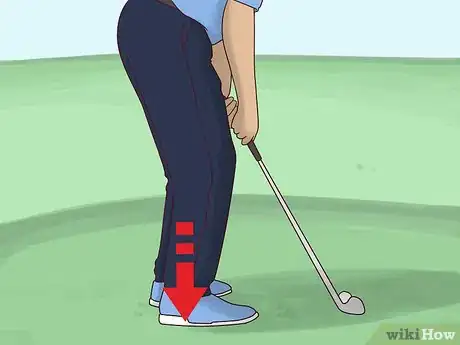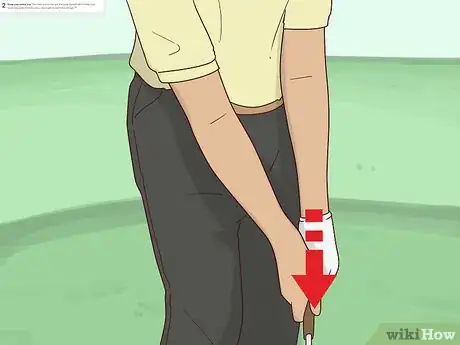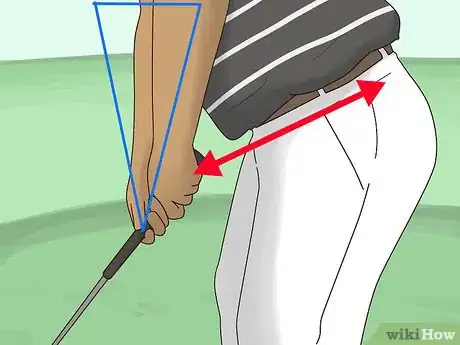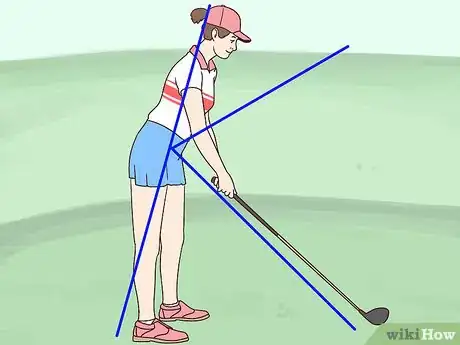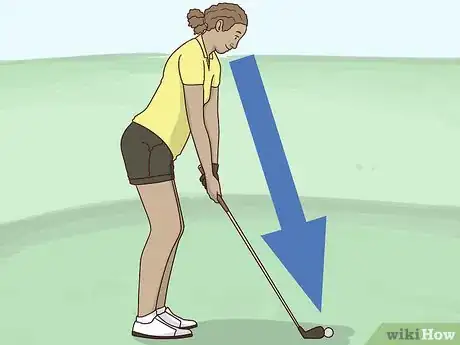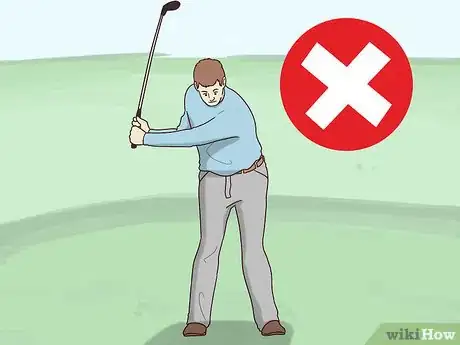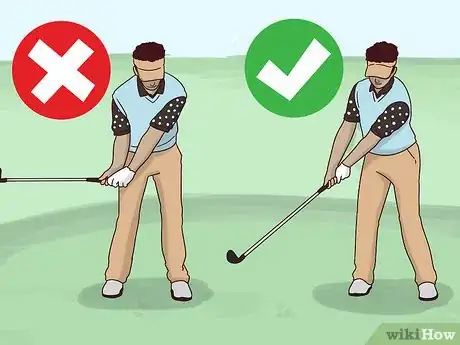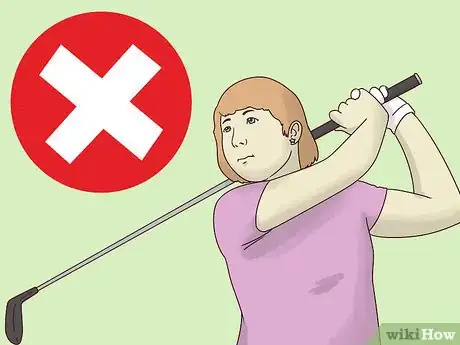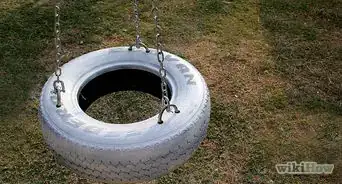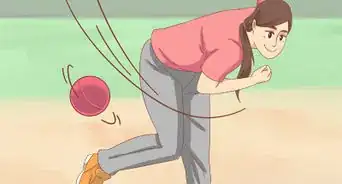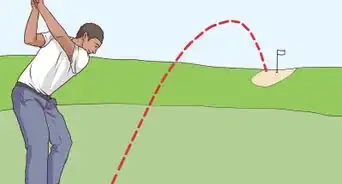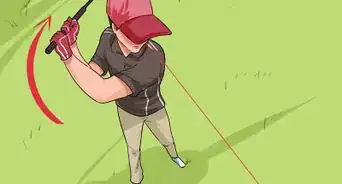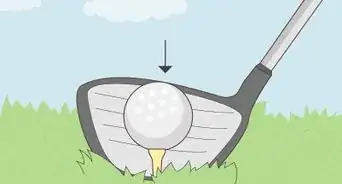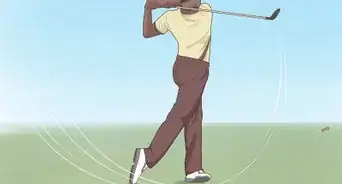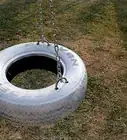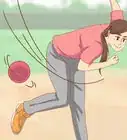This article was co-authored by Michael Metz and by wikiHow staff writer, Sophia Latorre. Michael Metz is a Golf Instructor and the Director of Instruction at Simi Hills Golf Course. With more than 15 years of experience, Michael is adept at coaching all facets of Golf. Mike uses technology, such as Flightscope, V1 Swing Suite, Blast Motion, and BodiTrak pressure mapping, to provide advanced golf training with quick results.
This article has been viewed 59,578 times.
If you’ve mastered the basics of golf, but want to improve your swing, you can adjust your stance, position, and grip. Develop a pre-shot routine to ensure you, and the ball, are lined up correctly. Avoid bad habits such as taking your eye off the ball, holding your breath, and trying to get speed by swinging your arms rather than your torso. With a bit of practice, you can improve your golf swing and therefore your score as well.
Steps
Getting into Position
-
1Visualize the shot. When you approach a shot, imagine yourself hitting the ball beautifully so that it lands exactly where you want it to. Avoid thinking of things that could go wrong, and instead focus on everything going right. Imagine the perfect shot in your mind’s eye.
-
2Develop a pre-shot routine. Take your time when setting up to hit the ball to ensure you have proper alignment. You should also ensure your ball is properly aligned between the left heel and the center.[1]Advertisement
-
3Position yourself in line with the flag. Imagine a line between the ball and the flag and put your clubface square to the line. Stand parallel to the line for the perfect golf swing.[2]
-
4Adjust your stance.[3] If you are stance is off, your shot will be off. Ensure that your feet are shoulder-width apart. Keep your feet, knees, hips, and shoulders parallel to the imaginary line leading to the target. Your right foot should be at a right angle to the line of flight, while the left foot should be slightly open.[4]
Perfecting Your Form
-
1Put your weight on the balls of your feet. Your body weight should not be in the heels, but on the balls of your feet. This will allow you to easily twist your back foot as you complete the downswing. Ensure your weight is evenly distributed between both feet.[5]
-
2Keep your hands low. The lower your hands are, the lower the ball will fly. Keep your hands low in the finish to reduce the height of your follow through.[6]
-
3Stay on-plane. If you are right-handed, your right forearm should be parallel to your spine in the backswing. Your left wrist should be straight and your elbows and arms should form a tight triangle.[7]
-
4Control your clubface. Begin with a standard grip and twist your bottom hand so that it faces away from you in the backswing. Keep it facing away from you the whole swing, as if you are wiping your palm across a flat surface.[8]
-
5Stay in your K. The K is the angle formed in your back leg and is determined by the bend in your knee. Create the K by bending forward from the hip sockets and back from the knees. Flexing your back leg correctly aligns the joints on top of each other and creates room for your arms to swing.[9]
Avoiding Bad Habits
-
1Identify your weakness. Keep simple statistics of your golf games to identify what you are having trouble with. You can even use a website such as Shot by Shot, or an app like Golf Stats, to help you electronically track your rounds. This will help you learn what areas you need to improve on to get the perfect golf swing.[10]
-
2Don’t take your eye off the ball. Avoid looking at the flag, the club, or other parts of the course when you are taking your shot. Keep your head down, focus on the ball, and let your body naturally complete the swing.
-
3Don’t get flippy. Flippiness is an early release that occurs when your body gets too far in front of the golf ball. Establish a firm left side to keep your head behind the ball and avoid the flip.[11]
-
4Avoid swinging your arms and wrists. You should rotate your torso rather than your arms and wrists to get power and speed behind your shot.[12] On the upswing, rotate your torso away from your target so your left shoulder is over your right leg rather than your left. On the downswing, rotate your torso toward your target so that your right shoulder is over your left leg.[13]
-
5Don’t hold your breath. Sometimes players will unknowingly hold their breath through the downswing. This actually reduces the distance of your shot. Exhale on the downswing to relax your muscles and allow your body to give the swing your full force.[14]
Expert Q&A
-
QuestionWhy is there no power in my golf swing?
 Michael MetzMichael Metz is a Golf Instructor and the Director of Instruction at Simi Hills Golf Course. With more than 15 years of experience, Michael is adept at coaching all facets of Golf. Mike uses technology, such as Flightscope, V1 Swing Suite, Blast Motion, and BodiTrak pressure mapping, to provide advanced golf training with quick results.
Michael MetzMichael Metz is a Golf Instructor and the Director of Instruction at Simi Hills Golf Course. With more than 15 years of experience, Michael is adept at coaching all facets of Golf. Mike uses technology, such as Flightscope, V1 Swing Suite, Blast Motion, and BodiTrak pressure mapping, to provide advanced golf training with quick results.
Golf Instructor Flexibility is a big issue. To get it to go far or to get more strength and speed built into your swings, you definitely need to have more rotation! You have to be able to take a bigger backswing and bigger follow-through while finishing in a balanced stance.
Flexibility is a big issue. To get it to go far or to get more strength and speed built into your swings, you definitely need to have more rotation! You have to be able to take a bigger backswing and bigger follow-through while finishing in a balanced stance.
References
- ↑ http://www.post-gazette.com/sports/golf/2009/04/19/10-tips-that-will-improve-your-golf-game/stories/200904190140
- ↑ http://www.videojug.com/how-to-do-a-great-golf-swing/
- ↑ Michael Metz. Golf Instructor. Expert Interview. 24 February 2022.
- ↑ http://www.videojug.com/how-to-do-a-great-golf-swing/
- ↑ http://www.videojug.com/how-to-do-a-great-golf-swing/
- ↑ https://www.golftipsmag.com/instruction/quick-tips/10-best-swing-tips-ever/
- ↑ https://www.golftipsmag.com/instruction/quick-tips/10-best-swing-tips-ever/
- ↑ http://www.post-gazette.com/sports/golf/2009/04/19/10-tips-that-will-improve-your-golf-game/stories/200904190140
- ↑ https://www.golftipsmag.com/instruction/quick-tips/10-best-swing-tips-ever/
- ↑ http://www.post-gazette.com/sports/golf/2009/04/19/10-tips-that-will-improve-your-golf-game/stories/200904190140
- ↑ https://www.golftipsmag.com/instruction/quick-tips/10-best-swing-tips-ever/
- ↑ Michael Metz. Golf Instructor. Expert Interview. 24 February 2022.
- ↑ http://www.post-gazette.com/sports/golf/2009/04/19/10-tips-that-will-improve-your-golf-game/stories/200904190140
- ↑ http://www.golf.com/instruction/golf-instruction-39-ways-fix-everything

